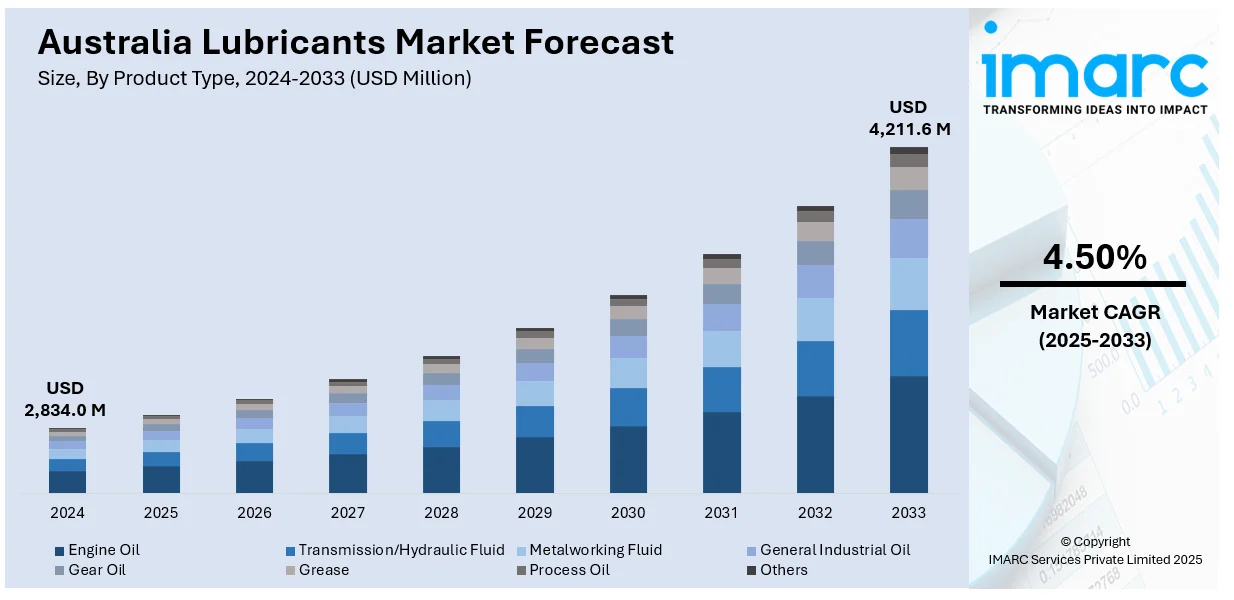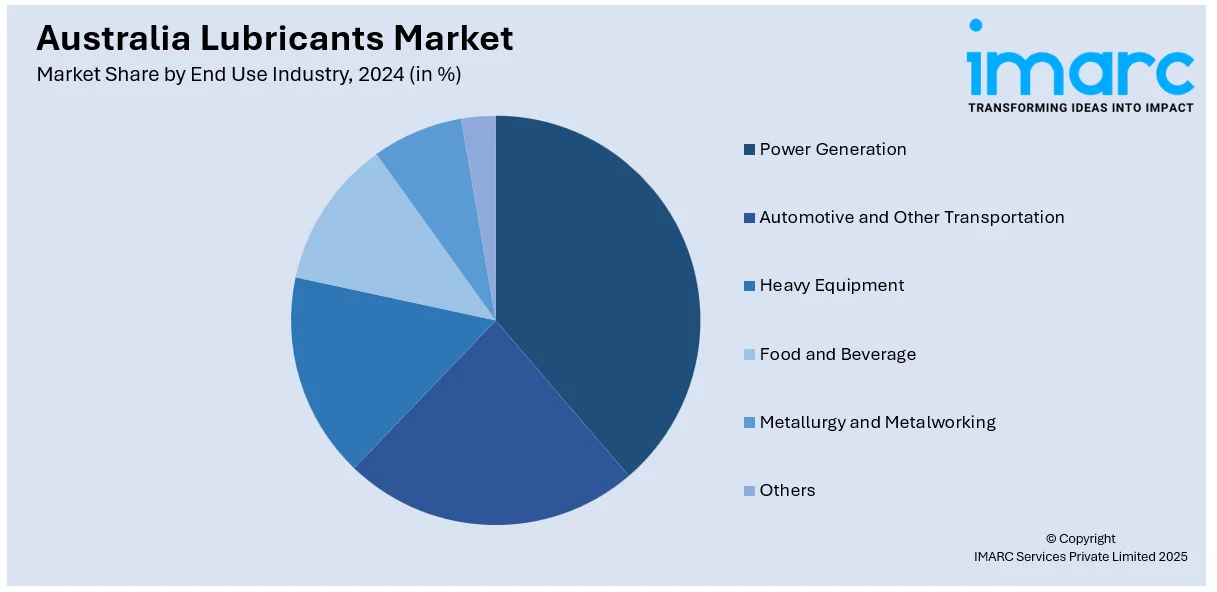
Australia Lubricants Market Size, Share, Trends and Forecast by Product Type, Base Oil, End Use Industry, and Region, 2025-2033
Australia Lubricants Market Overview:
The Australia lubricants market size reached USD 2,834.0 Million in 2024. Looking forward, IMARC Group expects the market to reach USD 4,211.6 Million by 2033, exhibiting a growth rate (CAGR) of 4.50% during 2025-2033. The market is driven by the heightened vehicle ownership, fueled by population growth and rising disposable incomes, increase in industrial operations, particularly in mining, construction, and manufacturing, and implementation of frameworks focused on reducing carbon emissions and promoting sustainability.
|
Report Attribute
|
Key Statistics
|
|---|---|
|
Base Year
|
2024 |
|
Forecast Years
|
2025-2033
|
|
Historical Years
|
2019-2024
|
| Market Size in 2024 | USD 2,834.0 Million |
| Market Forecast in 2033 | USD 4,211.6 Million |
| Market Growth Rate 2025-2033 | 4.50% |
Australia Lubricants Market Trends:
Innovations in Automotive Sector and Rise in Vehicle Ownership
The rise in innovations in the automotive industry is impelling the growth of the market. Increasing vehicle ownership, fueled by population growth and rising disposable incomes, is driving the demand for engine oils, transmission fluids, and gear oils. To date, the passenger vehicle market has been the most prominent, though commercial and off-road vehicles are also major users of lubricants. In addition, the increasing demand for personal mobility is rising private car sales, further enhancing lubricant consumption. Advances in engine technology, which necessitate high-performance semi-synthetic and synthetic lubricants, are contributing to the market growth. When vehicle makers recommend more sophisticated and long-interval lubricants, user awareness and demand shift toward premium lubricants. Furthermore, the growth in ride-sharing and logistics businesses is raising the maintenance frequency of the vehicles, which in turn drives lubricant usage. Together, these factors turn the automotive market into a backbone of market development. The IMARC Group predicts that the Australia automotive market size is expected to reach 2.50 Million Units by 2033.

To get more information of this market, Request Sample
Industrial Advancements and Infrastructure Development
The increase in industrial operations, particularly in mining, construction, and manufacturing, has been the key to driving lubricant demand throughout Australia. The mining industry, which is a backbone of the Australian economy, demands heavy-duty lubricants for machinery that works under harsh conditions. Hydraulic fluids, gear oils, and greases are widely utilized in equipment to maintain operational efficiency, reduce wear and tear, and prolong equipment life. Concurrently, private and public-large-scale infrastructure developments, like roadways, railways, and urban initiatives, are creating the need for construction machines and vehicles in huge numbers. Such machines necessitate frequent greasing to help them function maximally, prompting demand for purpose-specific industrial lubricants. To top it, Australia's intent to develop remote regions and upgrade its logistics platform further drives the usage of lubricant. In the 2025-26 Budget, the Australian Government sanctioned $17.1 billion for new and existing road and rail developments. This is further going to increase the usage of lubricants in vehicles used for development purposes.
Transition to High-Performance and Environmentally Friendly Lubricants
The increasing adoption of synthetic and bio-based lubricants reflects a significant shift in market dynamics, driven by environmental regulations and performance expectations. Regulatory frameworks focused on reducing carbon emissions and promoting sustainability are prompting industries and individuals to transition from conventional to eco-friendly lubricants. The Australian Government’s environmental policies, such as waste oil management programs and incentives for clean technologies, are influencing lubricant formulations and product offerings. Simultaneously, end-users are demanding lubricants that offer superior thermal stability, longer drain intervals, and enhanced protection under high-stress conditions. Synthetic lubricants meet these needs by reducing maintenance frequency and improving overall machinery efficiency. As the circular economy gains traction, manufacturers are also investing in the development of biodegradable lubricants and promoting recycling and re-refining of used oils. For instance, in 2024, Viva Energy Australia unveiled the Shell PANOLIN range of biodegradable lubricants to facilitate sustainability without degrading performance.
Australia Lubricants Market Segmentation:
IMARC Group provides an analysis of the key trends in each segment of the market, along with forecasts at the country and regional levels for 2025-2033. Our report has categorized the market based on product type, base oil, and end use industry.
Product Type Insights:
- Engine Oil
- Transmission/Hydraulic Fluid
- Metalworking Fluid
- General Industrial Oil
- Gear Oil
- Grease
- Process Oil
- Others
The report has provided a detailed breakup and analysis of the market based on the product type. This includes engine oil, transmission/hydraulic fluid, metalworking fluid, general industrial oil, gear oil, grease, process oil, and others.
Base Oil Insights:
- Mineral Oil
- Synthetic Oil
- Bio-based Oil
A detailed breakup and analysis of the market based on the base oil have also been provided in the report. This includes mineral oil, synthetic oil, and bio-based oil.
End Use Industry Insights:

- Power Generation
- Automotive and Other Transportation
- Heavy Equipment
- Food and Beverage
- Metallurgy and Metalworking
- Others
A detailed breakup and analysis of the market based on the end use industry have also been provided in the report. This includes power generation, automotive and other transportation, heavy equipment, food and beverage, metallurgy and metalworking, and others.
Regional Insights:
- Australia Capital Territory & New South Wales
- Victoria & Tasmania
- Queensland
- Northern Territory & Southern Australia
- Western Australia
The report has also provided a comprehensive analysis of all the major regional markets, which include Australia Capital Territory & New South Wales, Victoria & Tasmania, Queensland, Northern territory & Southern Australia, and Western Australia.
Competitive Landscape:
The market research report has also provided a comprehensive analysis of the competitive landscape. Competitive analysis such as market structure, key player positioning, top winning strategies, competitive dashboard, and company evaluation quadrant has been covered in the report. Also, detailed profiles of all major companies have been provided.
Australia Lubricants Market Report Coverage:
| Report Features | Details |
|---|---|
| Base Year of the Analysis | 2024 |
| Historical Period | 2019-2024 |
| Forecast Period | 2025-2033 |
| Units | Million USD |
| Scope of the Report | Exploration of Historical Trends and Market Outlook, Industry Catalysts and Challenges, Segment-Wise Historical and Future Market Assessment:
|
| Product Types Covered | Engine Oil, Transmission/Hydraulic Fluid, Metalworking Fluid, General Industrial Oil, Gear Oil, Grease, Process Oil, Others |
| Base Oils Covered | Mineral Oil, Synthetic Oil, Bio-based Oil |
| End Use Industries Covered | Power Generation, Automotive and Other Transportation, Heavy Equipment, Food and Beverage, Metallurgy and Metalworking, Others |
| Regions Covered | Australia Capital Territory & New South Wales, Victoria & Tasmania, Queensland, Northern territory & Southern Australia, Western Australia |
| Customization Scope | 10% Free Customization |
| Post-Sale Analyst Support | 10-12 Weeks |
| Delivery Format | PDF and Excel through Email (We can also provide the editable version of the report in PPT/Word format on special request) |
Key Questions Answered in This Report:
- How has the Australia lubricants market performed so far and how will it perform in the coming years?
- What is the breakup of the Australia lubricants market on the basis of product type?
- What is the breakup of the Australia lubricants market on the basis of base oil?
- What is the breakup of the Australia lubricants market on the basis of end use industry?
- What is the breakup of the Australia lubricants market on the basis of region?
- What are the various stages in the value chain of the Australia lubricants market?
- What are the key driving factors and challenges in the Australia lubricants market?
- What is the structure of the Australia lubricants market and who are the key players?
- What is the degree of competition in the Australia lubricants market?
Key Benefits for Stakeholders:
- IMARC’s industry report offers a comprehensive quantitative analysis of various market segments, historical and current market trends, market forecasts, and dynamics of the Australia lubricants market from 2019-2033.
- The research report provides the latest information on the market drivers, challenges, and opportunities in the Australia lubricants market.
- Porter's five forces analysis assist stakeholders in assessing the impact of new entrants, competitive rivalry, supplier power, buyer power, and the threat of substitution. It helps stakeholders to analyze the level of competition within the Australia lubricants industry and its attractiveness.
- Competitive landscape allows stakeholders to understand their competitive environment and provides an insight into the current positions of key players in the market.
Need more help?
- Speak to our experienced analysts for insights on the current market scenarios.
- Include additional segments and countries to customize the report as per your requirement.
- Gain an unparalleled competitive advantage in your domain by understanding how to utilize the report and positively impacting your operations and revenue.
- For further assistance, please connect with our analysts.
 Request Customization
Request Customization
 Speak to an Analyst
Speak to an Analyst
 Request Brochure
Request Brochure
 Inquire Before Buying
Inquire Before Buying




.webp)




.webp)












